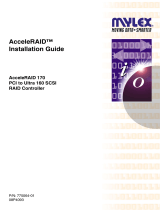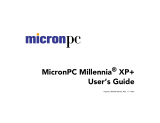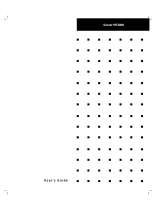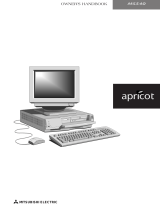
()
n n n n n n n
n n n n n n n
n n n n n n n
n n n n n n n
n n n n n n n
n n n n n n n
n n n n n n n
n n n n n n n
n n n n n n n
n n n n n n n
n n n n n n n
n n n n n n n
n n n n n n n
n n n n n n n
User’s Guide
Server LC1400

xxx

()
n n n n n n n
n n n n n n n
n n n n n n n
n n n n n n n
n n n n n n n
n n n n n n n
n n n n n n n
n n n n n n n
n n n n n n n
n n n n n n n
n n n n n n n
n n n n n n n
n n n n n n n
n n n n n n n
User’s Guide
Server LC1400




Using Your NEC Versa 1
EXPRESS5800 LC1400 SERIES
User's Guide

Proprietary Notice and Liability Disclaimer
The information disclosed in this document, including all designs and related materials, is the valuable
property of NEC Computer Systems Division, Packard Bell NEC, Inc. (hereinafter “NECCSD”) and/or its
licensors. NECCSD and/or its licensors, as appropriate, reserve all patent, copyright and other proprietary
rights to this document, including all design, manufacturing, reproduction, use, and sales rights thereto,
except to the extent said rights are expressly granted to others.
The NECCSD product(s) discussed in this document are warranted in accordance with the terms of the
Warranty Statement accompanying each product. However, actual performance of each such product is
dependent upon factors such as system configuration, customer data, and operator control. Since
implementation by customers of each product may vary, the suitability of specific product configurations
and applications must be determined by the customer and is not warranted by NECCSD.
To allow for design and specification improvements, the information in this document is subject to change
at any time, without notice. Reproduction of this document or portions thereof without prior written
approval of NECCSD is prohibited.
Trademarks
INTEL is a registered trademark of Intel Corporation.
MS-DOS is a registered trademark of Microsoft Corporation.
Pentium is a registered trademark of Intel Corporation.
All other product, brand, or trade names used in this publication are the trademarks or registered trademarks of their respective
trademark owners.
PN: 102177
First Issue — September 1998
Copyright 1998
NEC Computer Systems Division
Packard Bell NEC, Inc.
1 Packard Bell Way
Sacramento, CA 95828-0903
All Rights Reserved

Contents iii
Contents
1 System Overview
Overview.............................................................................................................................. 1-2
System Chassis..................................................................................................................... 1-5
Power Supply........................................................................................................................ 1-7
Peripheral Bays..................................................................................................................... 1-7
SAF-TE Board...................................................................................................................... 1-7
System Board Features.......................................................................................................... 1-8
Pentium II Processor................................................................................................... 1-9
System Memory.......................................................................................................... 1-9
I/O Expansion Slots ...................................................................................................1-10
Real-Time Clock/Calendar.........................................................................................1-11
BIOS .........................................................................................................................1-11
IDE Controller...........................................................................................................1-11
Network Controller....................................................................................................1-11
SCSI Controller .........................................................................................................1-12
Video Controller........................................................................................................1-12
Peripheral Controller..................................................................................................1-13
Serial Ports ..................................................................................................... 1-13
Parallel Port.................................................................................................... 1-13
External Device Connectors.......................................................................................1-13
System Board Management Controller (BMC)...........................................................1-13
System Security...................................................................................................................1-14
Security with Mechanical Locks and Monitoring........................................................1-14
Software Locks via the System Setup Utility..............................................................1-14
2 Setting Up the System
Overview.............................................................................................................................. 2-2
Selecting a Site ..................................................................................................................... 2-2
Unpacking the System........................................................................................................... 2-3
Rack-Mount Subsystem Assembly........................................................................................ 2-4
Before You Begin....................................................................................................... 2-4
Static Precautions........................................................................................................ 2-4
Assembly.................................................................................................................... 2-5
Getting Familiar with the System .......................................................................................... 2-8
Front View with Front Door Closed ............................................................................ 2-8
Front View with Front Door Opened........................................................................... 2-9
Rear View..................................................................................................................2-11
Status Indicator LED Descriptions .............................................................................2-12
Making Connections............................................................................................................2-14
Setting the Line Voltage.......................................................................................................2-15
Connecting the Power Cord(s)..............................................................................................2-17
Powering On Your System...................................................................................................2-18

iv Contents
3 Configuring Your System
Configuring Your System...................................................................................................... 3-2
BIOS Setup Utility................................................................................................................ 3-3
Using the BIOS Setup Utility...................................................................................... 3-3
BIOS Setup Configuration Settings............................................................................. 3-4
Main Menu................................................................................................................. 3-5
Primary/Secondary IDE Master and Slave Submenu ....................................... 3-6
Keyboard Submenu......................................................................................... 3-7
Advanced Menu.......................................................................................................... 3-7
PCI Configuration Submenus.......................................................................... 3-8
PCI Device, Slot 1 - Slot 7 Submenus ............................................................. 3-8
Integrated Peripheral Configuration Submenu................................................. 3-9
Advanced Chipset Control .............................................................................. 3-10
Security Menu............................................................................................................3-10
Security menu (Continued).........................................................................................3-11
Server Menu ..............................................................................................................3-12
System Management Submenu........................................................................ 3-13
Server Management Information Submenu...................................................... 3-14
Console Redirection Submenu ........................................................................ 3-14
Boot Menu.................................................................................................................3-15
Boot Device Priority Submenu........................................................................ 3-15
Hard Drive Submenu ...................................................................................... 3-16
Removable Devices ........................................................................................ 3-16
Exit Menu..................................................................................................................3-17
Symbios Configuration Utility .............................................................................................3-18
Running the Symbios Configuration Utility................................................................3-18
Changing the Adapter and Device Configurations ......................................................3-19
Optional RAID Controllers ..................................................................................................3-22
Factory Installed Controllers......................................................................................3-22
Add-on Controller......................................................................................................3-23
DACCF Configuration Utility....................................................................................3-23
Configuring System Board Jumpers.....................................................................................3-24
Before You Begin......................................................................................................3-24
Moving System Board Jumpers..................................................................................3-26
Resetting the CMOS NVRAM...................................................................................3-27
Clearing and Changing the Passwords........................................................................3-27
Recovering the BIOS.................................................................................................3-27
Boot Block Write Protect...........................................................................................3-27
BMC Forced Update Mode ........................................................................................3-28
4 Upgrading Your System
General Information.............................................................................................................. 4-2
Static Precautions.................................................................................................................. 4-2
Preparing Your System for Upgrade...................................................................................... 4-3
Equipment Log ..................................................................................................................... 4-3
Opening the Front Door ........................................................................................................ 4-3
Removing a Side Panel ......................................................................................................... 4-4
Installing a Side Panel........................................................................................................... 4-5
Modifying the System Board................................................................................................. 4-6
Replacing the Real-time Clock Battery........................................................................ 4-6
Replacing the Pentium II Processor............................................................................. 4-8
Replacing the SECC Version .......................................................................... 4-9
Replacing the SEPP Version ........................................................................... 4-11

Contents v
Replacing the SECC2 Version......................................................................... 4-13
DIMMs......................................................................................................................4-15
Memory DIMM Configurations ...................................................................... 4-16
Installing DIMMs ........................................................................................... 4-17
Removing DIMMs.......................................................................................... 4-18
Option Boards......................................................................................................................4-19
Installation Considerations.........................................................................................4-19
Installing an Option Board .........................................................................................4-20
Removing an Option Board........................................................................................4-23
Installing a RAID Controller Board......................................................................................4-23
Hard Disk Drives.................................................................................................................4-24
Installing or Swapping a Hard Disk Drive in a Hot-swap Bay.....................................4-25
Installing or Swapping a Hard Disk Drive ..................................................................4-26
Removable Media Devices...................................................................................................4-29
Installing a 5.25-Inch Media Device...........................................................................4-30
Removing a 5.25-Inch Device....................................................................................4-35
5 Problem Solving
Problem Solving ................................................................................................................... 5-2
Static Precautions.................................................................................................................. 5-2
Troubleshooting Checklists................................................................................................... 5-3
Initial System Startup.................................................................................................. 5-3
Running New Application Software............................................................................ 5-4
After System Has Been Running Correctly.................................................................. 5-5
Additional Troubleshooting Procedures................................................................................. 5-6
Preparing the System for Diagnostic Testing............................................................... 5-6
Monitoring POST ....................................................................................................... 5-7
Verifying Proper Operation of Key System Indicators................................................. 5-8
Confirming Loading of the Operating System ............................................................. 5-8
Specific Problems and Corrective Actions............................................................................. 5-9
Power LED Does Not Light ........................................................................................ 5-9
Incorrect or No Beep Code.........................................................................................5-10
No Characters Appear on Screen................................................................................5-10
Characters are Distorted or Incorrect..........................................................................5-11
System Cooling Fans Do Not Rotate..........................................................................5-11
Diskette Drive Activity LED Does Not Light.............................................................5-11
CD-ROM Drive Activity Light Does Not Light..........................................................5-12
Problems with Application Software..........................................................................5-12
Press F2 Key to Enter Setup: Prompt Does Not Display ............................................5-12
Enable F2 Prompt by Using SSU .................................................................... 5-13
Enable F2 Prompt by Changing a Jumper and Using SSU ............................... 5-14
Bootable CD-ROM Is Not Detected...........................................................................5-14
Problems with the Network..................................................................................................5-15
PNP Installation Tips...........................................................................................................5-16
BIOS User’s Information .....................................................................................................5-16
Error and Status Messages .........................................................................................5-16
POST Error Codes and Messages...............................................................................5-20

vi Contents
A System Cabling
System Cabling.....................................................................................................................A-2
Before You Begin.................................................................................................................A-2
Static Precautions..................................................................................................................A-2
Standard Configuration.........................................................................................................A-3
RAID Configuration .............................................................................................................A-6
B System Setup Utility
System Setup Utility (SSU)...................................................................................................B-2
Creating SSU Diskettes.........................................................................................................B-3
Running the SSU ..................................................................................................................B-4
Customizing the SSU..................................................................................................B-5
Launching a Task........................................................................................................B-6
Resource Configuration Add-in (RCA) Window .........................................................B-7
Defining an ISA Card .................................................................................................B-8
Adding and Removing ISA Cards ...............................................................................B-9
Modifying Resources................................................................................................B-10
Recommended Resource Settings..............................................................................B-11
System Resource Usage............................................................................................B-12
Multiboot Add-in (MBA) Window............................................................................B-13
Password Administration (PWA) Window ................................................................B-13
System Event Log (SEL) Window.............................................................................B-14
Exiting the SSU ..................................................................................................................B-15
C Emergency Management Port
Emergency Management Port ...............................................................................................C-2
How the EMP Works............................................................................................................C-3
EMP Requirements and Configurations.................................................................................C-5
Setting Up the Server for the EMP........................................................................................C-6
System Management Submenu....................................................................................C-6
Console Redirection Submenu ....................................................................................C-7
Main EMP Window..............................................................................................................C-7
Toolbar.......................................................................................................................C-7
Status Bar...................................................................................................................C-8
EMP Main Menu ........................................................................................................C-8
Server Control Operations...........................................................................................C-9
Connect .......................................................................................................... C-9
Power On/Off .................................................................................................C-10
Reset...............................................................................................................C-11
Phonebook..........................................................................................................................C-12
Management Plug-ins .........................................................................................................C-13
SEL Viewer..............................................................................................................C-13
SEL Viewer Menu Options.............................................................................C-14
Sensor Type Codes .........................................................................................C-15
Using the Sensor Type Code Table..................................................................C-15
SDR Viewer .............................................................................................................C-17
SDR Viewer Menu Options.............................................................................C-18
FRU Viewer..............................................................................................................C-18
FRU Viewer Menu Options.............................................................................C-19

Contents vii
D System Status Hardware Support Information
System Status Hardware Support Information .......................................................................D-2
Glossary
Equipment Log
Index

Using This Guide vii
Using This Guide
The LC1400 User’s Guide provides a quick reference to information about your system. Its
goal is to familiarize you with your system and the tasks necessary for system configuring
and upgrading.
This guide contains the following information:
n Chapter 1, “System Overview” provides an overview of your system and describes your
system’s major system components. See this chapter to familiarize yourself with your
system.
n Chapter 2, “Setting Up Your System” tells you how to select a site, unpack the system,
assemble the rack-mount subsystem, make cable connections, and power on your
system.
n Chapter 3, “Configuring Your System” tells you how to configure the system and
provides instructions for running the BIOS Setup Utility and the Symbios Configuration
Utility, which is used to configure SCSI devices in your system. This chapter also
provides information on system board jumper settings.
n Chapter 4, “Upgrades and Options” provides you with instructions for replacing the
processor and upgrading your system with optional memory, options cards, and
peripheral devices.
n Chapter 5, “Problem Solving” contains helpful information for solving problems that
might occur with your system.
n Appendix A, “System Cabling” includes cabling information for the onboard SCSI
controller, the onboard IDE controllers, and the optional RAID controllers.
n Appendix B, “System Setup Utility” provides information for configuring onboard
resources and add-in boards. It also provides information on viewing the system event
log.
n Appendix C, “Emergency Management Port” provides information on a feature that
provides an interface to the Emergency Management Port (EMP) Console Manager.
This interface allows remote server management via a modem or direct connection.
n Appendix D, “System Status Hardware Support Information” helps you identify a
system status hardware item indicated by one of several software monitoring
components.
n “Glossary” defines the standard acronyms and technical terms used in this manual.
n “Equipment Log” provides you with a sample equipment log for documenting the
system configuration and future updates you may make to your system.

viii Using This Guide
Text Conventions
This guide uses the following text conventions.
Warnings, cautions, and notes have the following meanings:
WARNING
Warnings alert you to situations that could result in serious personal injury or loss
of life.
CAUTION
Cautions indicate situations that can damage the system hardware or software.
Note: Notes give important information about the material being described.
n Names of keyboard keys are printed as they appear on the keyboard. For example, Ctrl,
Alt, or Enter.
n Text or keystrokes that you enter appear as boldface type. For example, type abc123 and
press ENTER.
n File names are printed in uppercase letters. For example, AUTOEXEC.BAT.

Using This Guide ix
Related Documents
In addition to this guide, the following system documentation is included with your server
either as electronic files on EXPRESSBUILDER or as paper copy shipped with your server.
n System Release Notes
Release Notes provide you with the latest information about your system. This
information was not available at the time your user’s guide was developed.
n Getting Started Sheet
The Getting Started Sheet provides several easy-to-follow steps to become familiar with
your server documentation and to complete your installation successfully.
n Network Operating System Configuration Guide
This guide contains supplemental instructions needed to install and configure your
server Windows NT v4.0, Novell NetWare v3.12, Novell NetWare v4.11, and Santa
Cruz Operation (SCO) OpenServer Release 5.04, and UNIXWare 7.0 Network
Operating Systems. This document is intended to complement the more detailed
procedural documents available from the vendor of the network operating system.

x Using This Guide
Safety Notices
n Caution: To reduce the risk of electric shock which could cause personal injury, follow
all safety notices. The symbols shown are used in your documentation and on your
equipment to indicate safety hazards.
n Warning: Lithium batteries can be dangerous. Improper handling of lithium batteries
may result in an explosion. Dispose of lithium batteries as required by local ordinance or
as normal waste if no local ordinance exists.
n Warning: The detachable power supply cords are intended to serve as the disconnect
devices.
n Warning: This equipment uses 3-wire, grounded power cords. To prevent electrical
hazards, do not remove or defeat the ground prong on the power cords. Replace a power
cord if it gets damaged. Contact your dealer for an exact replacement.
n Warning: The DC push-button on/off switch on the front panel does not turn off the
system AC power. Also, +5vdc is present on the system board whenever the AC power
cords are connected between the system and an AC outlet. Before doing the procedures
in this manual, make sure that your system is powered off and unplug the AC power
cords from the back of the chassis. Failure to disconnect power before opening your
system can result in personal injury and equipment damage.
In the U.S.A. and Canada, the power cord must be a UL-listed detachable power cord (in
Canada, CSA-certified), type ST or SJT, 16 AWG, 3-conductor, provided with a molded-on
NEMA type 5-15 P plug cap at one end and a molded-on cord connector body at the other
end. The cord length must not exceed 9 feet (2.7 meters).
Outside the U.S.A. and Canada, the plug must be rated for 250 VAC, 10 amp minimum,
and must display an international agency approval marking. The cord must be suitable for
use in the end-user country. Consult your dealer or the local electrical authorities if you are
unsure of the type of power cord to use in your country. The voltage change occurs via a
switch in the power supply.
n Warning: Under no circumstances should the user attempt to disassemble the power
supply. The power supply has no user-replaceable parts. Inside the power supply are
hazardous voltages that can cause serious personal injury. A defective power supply
must be returned to your dealer.

Using This Guide xi
Safety Notices for Users Outside of the U.S.A. and Canada
n PELV (Protected Extra-Low Voltage) Integrity: To ensure the extra-low voltage
integrity of the equipment, connect only equipment with mains-protected electrically-
compatible circuits to the external ports.
n Remote Earths: To prevent electrical shock, connect all local (individual office)
computers and computer support equipment to the same electrical circuit of the building
wiring. If you are unsure, check the building wiring to avoid remote earth conditions.
n Earth Bonding: For safe operation, only connect the equipment to a building supply
that is in accordance with current wiring regulations in your country. In the U.K., those
regulations are the IEE.

xii Using This Guide
Care and Handling
Use the following guidelines to properly handle and care for your system.
Protect the system from extremely low or high temperatures.
Let the system warm (or cool) to room temperature before using
it.
Keep the system away from magnetic forces.
Keep the system dry. Do not wash the
system with a wet cloth or pour fluid
into it.
Protect the system from being bumped or
dropped.
Check the system for condensation. If
condensation exists, allow it to evaporate
before powering on the system.
Keep the system away from dust, sand,
and dirt.

1
System Overview
n Overview
n System Chassis
n Power Supply
n Peripheral Bays
n SAF-TE (SCSI Accessed Fault Tolerant Enclosure)
Board
n System Board Features
n System Security
Page is loading ...
Page is loading ...
Page is loading ...
Page is loading ...
Page is loading ...
Page is loading ...
Page is loading ...
Page is loading ...
Page is loading ...
Page is loading ...
Page is loading ...
Page is loading ...
Page is loading ...
Page is loading ...
Page is loading ...
Page is loading ...
Page is loading ...
Page is loading ...
Page is loading ...
Page is loading ...
Page is loading ...
Page is loading ...
Page is loading ...
Page is loading ...
Page is loading ...
Page is loading ...
Page is loading ...
Page is loading ...
Page is loading ...
Page is loading ...
Page is loading ...
Page is loading ...
Page is loading ...
Page is loading ...
Page is loading ...
Page is loading ...
Page is loading ...
Page is loading ...
Page is loading ...
Page is loading ...
Page is loading ...
Page is loading ...
Page is loading ...
Page is loading ...
Page is loading ...
Page is loading ...
Page is loading ...
Page is loading ...
Page is loading ...
Page is loading ...
Page is loading ...
Page is loading ...
Page is loading ...
Page is loading ...
Page is loading ...
Page is loading ...
Page is loading ...
Page is loading ...
Page is loading ...
Page is loading ...
Page is loading ...
Page is loading ...
Page is loading ...
Page is loading ...
Page is loading ...
Page is loading ...
Page is loading ...
Page is loading ...
Page is loading ...
Page is loading ...
Page is loading ...
Page is loading ...
Page is loading ...
Page is loading ...
Page is loading ...
Page is loading ...
Page is loading ...
Page is loading ...
Page is loading ...
Page is loading ...
Page is loading ...
Page is loading ...
Page is loading ...
Page is loading ...
Page is loading ...
Page is loading ...
Page is loading ...
Page is loading ...
Page is loading ...
Page is loading ...
Page is loading ...
Page is loading ...
Page is loading ...
Page is loading ...
Page is loading ...
Page is loading ...
Page is loading ...
Page is loading ...
Page is loading ...
Page is loading ...
Page is loading ...
Page is loading ...
Page is loading ...
Page is loading ...
Page is loading ...
Page is loading ...
Page is loading ...
Page is loading ...
Page is loading ...
Page is loading ...
Page is loading ...
Page is loading ...
Page is loading ...
Page is loading ...
Page is loading ...
Page is loading ...
Page is loading ...
Page is loading ...
Page is loading ...
Page is loading ...
Page is loading ...
Page is loading ...
Page is loading ...
Page is loading ...
Page is loading ...
Page is loading ...
Page is loading ...
Page is loading ...
Page is loading ...
Page is loading ...
Page is loading ...
Page is loading ...
Page is loading ...
Page is loading ...
Page is loading ...
Page is loading ...
Page is loading ...
Page is loading ...
Page is loading ...
Page is loading ...
Page is loading ...
Page is loading ...
Page is loading ...
Page is loading ...
Page is loading ...
Page is loading ...
Page is loading ...
Page is loading ...
Page is loading ...
Page is loading ...
Page is loading ...
Page is loading ...
Page is loading ...
Page is loading ...
Page is loading ...
Page is loading ...
Page is loading ...
Page is loading ...
Page is loading ...
Page is loading ...
Page is loading ...
Page is loading ...
Page is loading ...
Page is loading ...
Page is loading ...
Page is loading ...
Page is loading ...
Page is loading ...
Page is loading ...
Page is loading ...
Page is loading ...
Page is loading ...
Page is loading ...
Page is loading ...
Page is loading ...
Page is loading ...
Page is loading ...
Page is loading ...
Page is loading ...
Page is loading ...
-
 1
1
-
 2
2
-
 3
3
-
 4
4
-
 5
5
-
 6
6
-
 7
7
-
 8
8
-
 9
9
-
 10
10
-
 11
11
-
 12
12
-
 13
13
-
 14
14
-
 15
15
-
 16
16
-
 17
17
-
 18
18
-
 19
19
-
 20
20
-
 21
21
-
 22
22
-
 23
23
-
 24
24
-
 25
25
-
 26
26
-
 27
27
-
 28
28
-
 29
29
-
 30
30
-
 31
31
-
 32
32
-
 33
33
-
 34
34
-
 35
35
-
 36
36
-
 37
37
-
 38
38
-
 39
39
-
 40
40
-
 41
41
-
 42
42
-
 43
43
-
 44
44
-
 45
45
-
 46
46
-
 47
47
-
 48
48
-
 49
49
-
 50
50
-
 51
51
-
 52
52
-
 53
53
-
 54
54
-
 55
55
-
 56
56
-
 57
57
-
 58
58
-
 59
59
-
 60
60
-
 61
61
-
 62
62
-
 63
63
-
 64
64
-
 65
65
-
 66
66
-
 67
67
-
 68
68
-
 69
69
-
 70
70
-
 71
71
-
 72
72
-
 73
73
-
 74
74
-
 75
75
-
 76
76
-
 77
77
-
 78
78
-
 79
79
-
 80
80
-
 81
81
-
 82
82
-
 83
83
-
 84
84
-
 85
85
-
 86
86
-
 87
87
-
 88
88
-
 89
89
-
 90
90
-
 91
91
-
 92
92
-
 93
93
-
 94
94
-
 95
95
-
 96
96
-
 97
97
-
 98
98
-
 99
99
-
 100
100
-
 101
101
-
 102
102
-
 103
103
-
 104
104
-
 105
105
-
 106
106
-
 107
107
-
 108
108
-
 109
109
-
 110
110
-
 111
111
-
 112
112
-
 113
113
-
 114
114
-
 115
115
-
 116
116
-
 117
117
-
 118
118
-
 119
119
-
 120
120
-
 121
121
-
 122
122
-
 123
123
-
 124
124
-
 125
125
-
 126
126
-
 127
127
-
 128
128
-
 129
129
-
 130
130
-
 131
131
-
 132
132
-
 133
133
-
 134
134
-
 135
135
-
 136
136
-
 137
137
-
 138
138
-
 139
139
-
 140
140
-
 141
141
-
 142
142
-
 143
143
-
 144
144
-
 145
145
-
 146
146
-
 147
147
-
 148
148
-
 149
149
-
 150
150
-
 151
151
-
 152
152
-
 153
153
-
 154
154
-
 155
155
-
 156
156
-
 157
157
-
 158
158
-
 159
159
-
 160
160
-
 161
161
-
 162
162
-
 163
163
-
 164
164
-
 165
165
-
 166
166
-
 167
167
-
 168
168
-
 169
169
-
 170
170
-
 171
171
-
 172
172
-
 173
173
-
 174
174
-
 175
175
-
 176
176
-
 177
177
-
 178
178
-
 179
179
-
 180
180
-
 181
181
-
 182
182
-
 183
183
-
 184
184
-
 185
185
-
 186
186
-
 187
187
-
 188
188
-
 189
189
-
 190
190
-
 191
191
-
 192
192
-
 193
193
-
 194
194
-
 195
195
-
 196
196
-
 197
197
-
 198
198
-
 199
199
-
 200
200
NEC LC1400 User manual
- Type
- User manual
- This manual is also suitable for
Ask a question and I''ll find the answer in the document
Finding information in a document is now easier with AI
Related papers
-
NEC 320LB User manual
-
NEC MC2400 User manual
-
NEC Express5800/LS2400 User guide
-
NEC Express5800/ES1400 User guide
-
NEC MH4500 User manual
-
NEC NEAX Express User guide
-
NEC Express5800/ES1200 User guide
-
NEC Express5800/120Mc2 Upgrade Guide
-
NEC Express5800/120Lf User guide
-
NEC Express5800/120Ed Installation guide
Other documents
-
Intel MB440LX User manual
-
Gianni Industries MOD-AD500DB User manual
-
Intel Work Light 754458-002 User manual
-
Intel 5800/120Ld User manual
-
 Mylex AcceleRAID 170 User manual
Mylex AcceleRAID 170 User manual
-
Gateway ALR 9250R User manual
-
 micronPC Millennia XP+ User manual
micronPC Millennia XP+ User manual
-
 Zenith Data Systems MT2000 User manual
Zenith Data Systems MT2000 User manual
-
Gateway ALR 9200 User manual
-
 Mitsubishi Electronics MS540 User manual
Mitsubishi Electronics MS540 User manual











































































































































































































